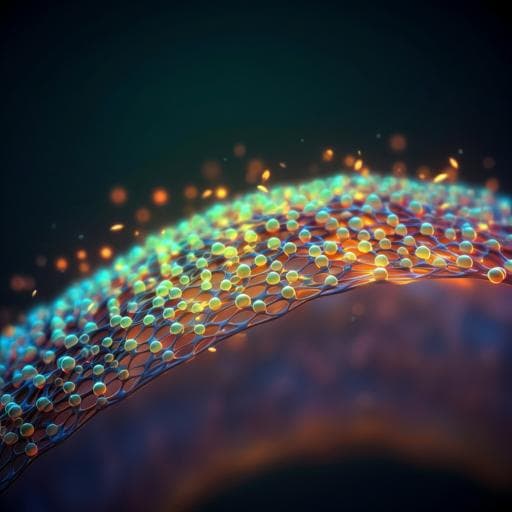
Medicine and Health
Liquid-metal-based three-dimensional microelectrode arrays integrated with implantable ultrathin retinal prosthesis for vision restoration
W. G. Chung, J. Jang, et al.
Discover how a groundbreaking 10 µm-thick soft artificial retina utilizing innovative flexible photosensitive transistors and EGaIn alloy electrodes holds the potential for improving vision restoration, as revealed by the research conducted by Won Gi Chung, Jiuk Jang, Gang Cui, Sanghoon Lee, Han Jeong, Haisu Kang, Hunkyu Seo, Sumin Kim, Enji Kim, Junwon Lee, Seung Geol Lee, Suk Ho Byeon, and Jang-Ung Park.
~3 min • Beginner • English
Introduction
Retinal degenerative diseases such as retinitis pigmentosa and age-related macular degeneration destroy photoreceptors but often spare inner retinal neurons (bipolar and ganglion cells), making electrical stimulation a viable route for vision restoration. Epiretinal prostheses, which place electrodes near the ganglion cell layer, are surgically attractive but limited by poor conformity to the curved, locally non-uniform degenerated retinal surface. Large electrode–cell gaps elevate activation thresholds, broaden current spread, and can inadvertently activate passing axons, degrading spatial selectivity and producing irregular percepts. Subretinal implants provide stable fixation but impose surgical challenges and risks. The study addresses the need for a soft, conformal, high-resolution epiretinal interface that minimizes mechanical mismatch, reduces electrode–cell distance, and selectively stimulates RGC somas to improve acuity and naturalistic vision.
Literature Review
Prior epiretinal and subretinal prostheses demonstrated phosphene generation but suffered from low visual acuity, high thresholds, and axonal activation due to geometric gaps and rigid flat electrodes. Three-dimensional microelectrodes can reduce electrode–cell distance and improve selectivity, yet most reported 3D electrodes are rigid, risking retinal damage and inflammation. Clinical devices like Argus exhibited long-term function but with mismatch-driven gaps and elevated thresholds. Pillar/spike designs improved proximity but remained mechanically mismatched. Liquid metals (eutectic gallium–indium) offer low modulus and processability (printing, patterning) with emerging evidence of biocompatibility, suggesting a path to soft 3D electrodes. Enhancing charge injection via nanostructured noble metals (for example, Pt black) can counteract impedance increases that accompany electrode miniaturization.
Methodology
Device design and fabrication: An ultrathin (≈10 µm) flexible artificial retina was built on an 8 µm polyimide substrate integrating phototransistor arrays and 3D liquid-metal (EGaIn) microelectrodes as stimulation sites. Phototransistors used 340 nm Si channels; Cr/Au/Pt source/drain/interconnects; 500 nm SiO2 dielectric; and 150 nm ITO gates, encapsulated with 1 µm parylene C. EGaIn pillars were directly printed onto drain electrodes using a high-resolution capillary-nozzle printing system under ~50 psi pressure with six-axis stage control. Pillar dimensions: typical height 60 µm and diameter 20 µm; diameter governed by nozzle inner diameter (5–50 µm), height by stage speed. After printing, an additional 1 µm parylene C encapsulated pillar sidewalls; tips were selectively opened by anisotropic O2 RIE. Platinum nanoclusters (Pt black) were electroplated locally onto the exposed tips using a PtCl4/lead acetate aqueous bath (0.1 mA, 60 s) to increase effective surface area. Tip geometry for electrochemical tests: ≈4 µm diameter (geometric area 25.12 µm^2), with pillar heights varied (0–120 µm) to study height effects.
Characterization: Phototransistor optoelectronics exhibited field-effect mobility ≈341 cm^2 V^-1 s^-1, on/off ≈1.61×10^6, Vth ≈2.6 V, response/recovery times 10/13 ms, and linear photoresponsivity versus intensity (470 nm). Imaging capability was shown using an eagle-shaped shadow mask. Electrochemical impedance spectroscopy and cyclic voltammetry quantified electrode properties: PtB/EGaIn pillars showed ≈210 kΩ impedance at 1 kHz and charge storage capacity ≈72.84 mC cm^-2, largely independent of pillar height. Mechanical characterization indicated a low effective modulus (≈234 kPa) due to liquid core, with PtB coating negligibly affecting softness.
Biocompatibility: In vitro live/dead assays with human retinal pigment epithelium cells showed 82% survival at 7 days and 98.3% live cells by flow cytometry apoptosis assay, meeting ISO 10993-5 criteria. In vivo (rd1 mice) biocompatibility over 5 weeks showed no bleeding/inflammation/cataracts, no macrophage/microglia accumulation, stable retinal thickness, and proper device positioning without electrode collapse.
Ex vivo electrophysiology: Isolated WT and rd1 mouse retinas (n=5 each) were placed RGC-side down on devices with 36 stim/record pairs (40 µm pitch between pairs) and 60 µm-tall 3D electrodes. For stimulation: Vcc = 5 V d.c.; Vd = 1 V pulses, 1 ms, 10 Hz. Blue light (470 nm) probed photo-responses. VEPs recorded under light without device operation; EEPs recorded under device operation in dark and under light of varying intensities. Heights of 3D pillars (0, 30, 60, 90, 120 µm) were compared.
Signal processing: Unsupervised machine learning processed 4,992 spikes. Hierarchical clustering performed primary grouping; K-means clustering refined classes with K=4 chosen via elbow method and silhouette coefficient. Cluster-wise average waveforms were analyzed to distinguish somatic versus axonal signatures.
In vivo experiments: 6×6-pixel artificial retina (pixel pitch 200 µm; device width 2 mm; pillar height 60 µm; diameter 20 µm) was epiretinally implanted into rd1 mice (n=3). Full-field blue illumination (470 nm, 1.80 mW cm^-2) and patterned 415 nm laser through an ellipsoidal shadow mask were applied. Multielectrode recordings captured EEPs, spike trains, and firing-rate maps; spatial analysis compared illuminated (pixels 1–9) versus dark-state regions (pixels 16–36). Optical coherence tomography assessed in vivo pillar integrity and retinal apposition.
Key Findings
- Soft 3D EGaIn pillar electrodes with Pt black–coated tips integrated onto ultrathin phototransistor arrays enabled conformal epiretinal interfacing without collapse and with low mechanical mismatch (effective modulus ≈234 kPa).
- Electrochemical performance: PtB/EGaIn pillars achieved ≈210 kΩ impedance at 1 kHz and charge storage capacity ≈72.84 mC cm^-2; these metrics were largely independent of pillar height.
- Phototransistor performance: mobility ≈341 cm^2 V^-1 s^-1; Ion/Ioff ≈1.61×10^6; Vth ≈2.6 V; response/recovery 10/13 ms; photocurrent scaled linearly with light intensity and enabled light-responsive stimulation pulses.
- Biocompatibility: In vitro cell viability 82% (live/dead) and 98.3% live cells (flow cytometry). In vivo 5-week monitoring showed no ocular inflammation/bleeding and no microglia/macrophage accumulation; retinal thickness unaffected.
- Ex vivo electrophysiology: Light alone elicited VEPs in WT but not rd1; with device operation, EEPs were comparable in WT and rd1 (≈68 µV vs 62 µV). Evoked firing rates increased with light intensity in both WT and rd1. 3D pillar electrodes increased RGC firing activity compared to flat electrodes; performance peaked around 60–90 µm height and declined at 120 µm, implicating mistargeting beyond RGC layer.
- Machine learning–based spike sorting indicated waveforms characteristic of RGC soma activation (sub-millisecond depolarization followed by repolarization), suggesting reduced axonal activation.
- In vivo (rd1): Under full-field and patterned illumination, devices produced robust, spatially localized RGC spiking. The spatial map of maximum firing rates matched the ellipsoidal illumination region, and illuminated pixels exhibited approximately fourfold higher firing rates than dark-state pixels (P < 0.0001). OCT confirmed pillars surrounded by retinal tissue without collapse.
- Overall, the system demonstrated effective, localized, light-driven epiretinal stimulation consistent with vision restoration in a blind mouse model.
Discussion
The study demonstrates that combining ultrathin, flexible phototransistors with soft, 3D liquid-metal microelectrodes overcomes critical epiretinal interface challenges: it reduces electrode–cell distance, conforms to non-uniform retinal topography, and minimizes tissue damage due to low modulus. Pt nanocluster-coated tips substantially improve electrochemical coupling, enabling high charge injection despite small stimulation sites. Height-independent impedance and charge storage capacity simplify device design across variable retinal geometries, while optimization of pillar height enhances soma targeting and reduces unintended axonal activation. Ex vivo and in vivo results show that light-controlled electrical stimulation elicits robust, spatially selective RGC responses in rd1 mice, providing a physiological basis for improved visual acuity and more naturalistic percepts compared to flat, rigid electrodes. Unsupervised clustering confirms somatic activation patterns, supporting the strategy’s selectivity. Collectively, these findings support the central hypothesis that soft 3D LM electrodes integrated with phototransistor arrays can restore localized retinal activity with better safety and selectivity, addressing limitations of current epiretinal prostheses.
Conclusion
A soft artificial retina integrating high-resolution phototransistor arrays with 3D liquid-metal microelectrodes enables minimally invasive, selective epiretinal stimulation. The platform achieves low-impedance, high–charge storage capacity tips (Pt black), fast and linear photoresponsivity, biocompatibility in vitro and in vivo, and spatially localized RGC activation in rd1 mice under patterned light, indicating potential for vision restoration. Future work includes scaling device area and pixel density for larger eyes, further miniaturizing electrodes (down to 5 µm diameter demonstrated by printing) toward higher acuity (theoretically ~20/160), and leveraging nanoscale surface engineering (e.g., Pt nanoclusters) to maintain low impedance with smaller sites. Translation to larger animal models and long-term chronic studies will be important next steps.
Limitations
- Current in vivo demonstration used a 6×6 (36-pixel) array constrained by mouse eye size; scalability to larger, thicker retinas remains to be validated experimentally.
- Miniaturization of stimulation sites increases impedance, potentially limiting effective stimulation; while Pt nanoclusters mitigate this, further materials and surface optimization are needed for high-acuity arrays.
- Optimal pillar height is critical; excessive height (>90 µm) reduced firing due to mistargeting beyond the RGC layer, indicating a need for patient-specific height tuning.
- Experiments were conducted in mice (rd1 model); functional vision outcomes in higher-order visual behavior and long-term chronic implantation were not assessed here.
- Although waveforms suggest predominant soma activation, axonal stimulation cannot be fully excluded.
Related Publications
Explore these studies to deepen your understanding of the subject.







